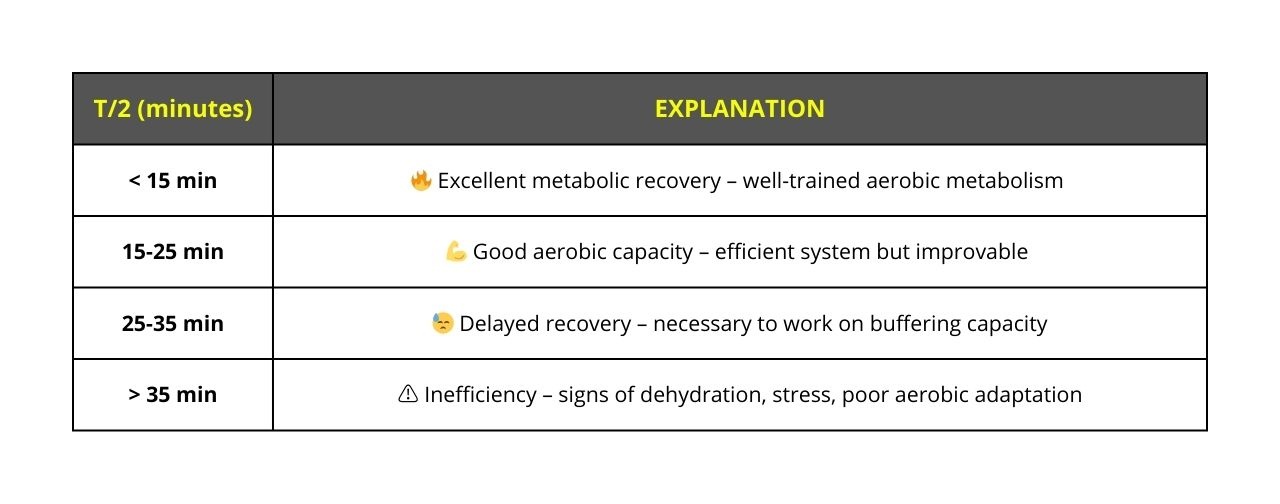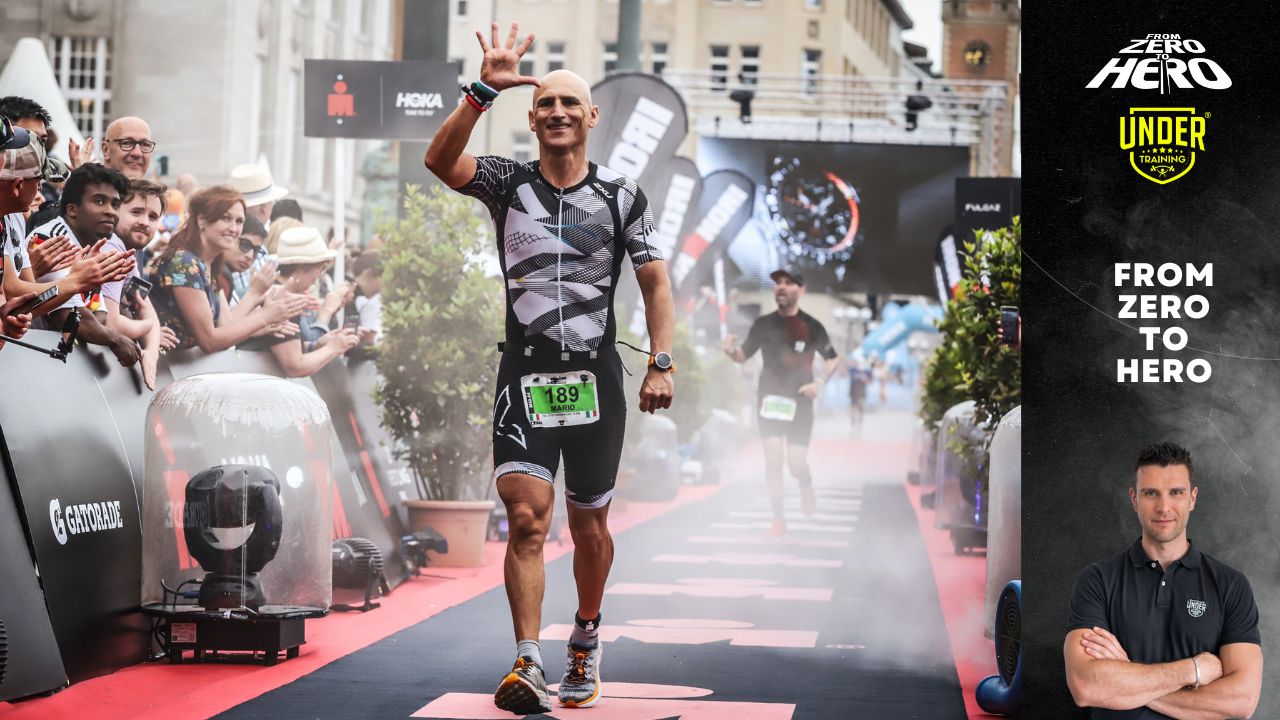Hello Athlete!
Today I want to talk to you about something really important related to exercise physiology!
If at least once in your life you have pushed yourself to the limit during an intense workout, you know well that feeling of muscle burn: the classic “sacred fire” in the quadriceps that cry out for vengeance.
Here, often behind that sensation, there he is, the much-discussed lactate!
But be careful: it’s not the enemy you thought.
Today, I’m going to introduce you to a key concept: the half-life of lactate, also known as T/2.
What is the half-life of lactate (T/2)?
The half-life of lactate is the time required for the concentration of lactate in the blood to decrease by 50% from the peak reached after intense exertion.
In practice: did you just do an insane sprint?
Do you measure the lactate (e.g., 18 mmol/L)?
When it drops to 9 mmol/L, you have reached your T/2.
And why is it so important?
Because it tells us how efficient your body is in recovery and energy recycling.
The more trained you are, the shorter your T/2 tends to be.
How is it measured?
The T/2 test is divided into two distinct but complementary phases:
PHASE 1: LACTATE ACCUMULATION
1. Preparation: Ensure that the athlete is in optimal condition: well-hydrated, rested for at least 24 hours from other intense efforts, and possibly fasting for 2-3 hours (or after a light meal).
2. Execution of maximal effort: Choose a high-intensity and short-duration activity to stimulate maximum lactate production.
Practical examples: ◦ 400 m sprint on the track ◦ 500 m at maximum on the rowing machine ◦ Wingate test ◦ 6 maximal 30” repeats on the air bike, with minimal recovery.
3. Wait: After the effort, wait 60-90 seconds: this is the time it takes for lactate to stabilize in the blood.
4. First sample: Perform a capillary blood draw (from the finger or earlobe) and measure the lactate concentration in the blood. This is your peak value.
PHASE 2: RECOVERY MONITORING
1. Recovery phase: The athlete immediately transitions to a recovery phase, which can be:
◦ Active: light walking, gentle cycling, or easy rowing
◦ Passive: total rest while sitting or lying down.
2. Periodic blood draws: Every 5 or 10 minutes, a capillary blood draw is repeated to monitor the lactate levels.
3. Identification of T/2: When the lactate concentration drops to 50% of the peak value, we have identified T/2.
📌 Example:
Peak = 18 mmol/L → T/2 = when it drops to 9 mmol/L. If this happens after 28 minutes, your T/2 is 28’.
📎 Important note: To ensure the validity of the test, make sure all variables are constant: time of day, ambient temperature, nutritional status, and hydration. Only then will you be able to compare your T/2 over time.
Why should you monitor the half-life of lactate?

Measuring the T/2 opens a true window into your internal engine. We’re not just talking about numbers on a sheet, but about data that tells the story of your metabolism in action. So what is the point of measuring it:
• 📊 Estimate post-exercise metabolic recovery: you can precisely understand how long it takes for your body to return to balance after exertion, thus optimizing loads and breaks in your training sessions.
• ⚡ Evaluate mitochondrial efficiency: efficient mitochondria = energy galore. The T/2 tells us how well your cellular “power plants” are working.
• ♻️ Understand how good you are at recycling lactate as fuel: the more efficient your body is, the less lactate remains in circulation and the more you can use it to produce new energy.
• ⏱ Personalize the recovery times between repetitions: no more copy-pasting workouts! Knowing the T/2 means adjusting the rest times to maintain the quality of the work.
• ⚠️ Identify early signs of overreaching or overtraining: a suddenly prolonged T/2 could be the alarm bell that saves you from a performance drop (or burnout!).
What are the reference values?
Once the T/2 is determined, it is possible to interpret the result through a qualitative scale:

Factors that influence T/2
Surely, the type of recovery is the first important factor to consider.
The way you choose to recover after exertion deeply affects the rate of lactate clearance.
Active recovery, such as a light walk or low-intensity cycling, stimulates blood flow and accelerates lactate metabolism, making it a winning strategy for those who want to get back on track quickly.
Another thing not to underestimate is the state of hydration.
Water is not just life, it is also performance!
A slight dehydration can drastically slow down the process of lactate elimination, altering blood viscosity and reducing the efficiency of metabolic transport.
Drink little = recover slowly.
If you don’t know how much you should drink daily based on your workouts, write to me at roberto@undertraining.ch for a free consultation.
Finally, the time of day, ambient temperature, and nutritional status are often underestimated elements that can completely change your body’s response.
Training on an empty stomach, in a warm or too cold environment, or at a time of day when you are less responsive can prolong recovery times and alter the T/2 reading.
Every detail matters!
Try to perform the test under the same conditions each time.

How can you improve your T/2?
Well, surely training is the first arrow you can shoot.
• Regular HIIT: Incorporate high-intensity interval training, such as 30 seconds at maximum intensity followed by 90 seconds of active recovery, repeated 8-10 times.
Do you want another classic example?
• The Tabata protocol: 20” ON / 10” OFF for 8 repetitions.• Anaerobic threshold training (90-100% LT2): Work near your second lactate threshold with exercises like 3×10 minutes at a sustained pace with 3 minutes of recovery. This stimulates the adaptation of the buffering system and improves lactate tolerance.
• Lactate clearance training: Alternate very intense phases (e.g., 2 minutes at 105% of the threshold) with slow segments (e.g., 3 minutes of light jogging). The goal is to teach your body to clear lactate while continuing to work.
• VO2max zone intervals (2-5 min): Use short but tough repeats, like 5×3 minutes at 95-100% of your maximum aerobic power, with 2-3 minutes of recovery. Perfect for improving maximum oxygen consumption and boosting your aerobic engine.

Other major aspects to take care of will be Nutrition, Integration, and Supplementation:
• Pre-workout carbohydrates with a medium/low glycemic index: to ensure a stable energy source during training without unwanted glycemic spikes. Examples? Oats, whole grain bread, not overly ripe bananas, or a small portion of basmati rice with a drizzle of oil.
• Sodium bicarbonate (0.3 g/kg of body weight): acts as a buffer against metabolic acidosis, delaying the onset of fatigue. It is especially useful in sports with short and intense efforts. However, caution: it should be taken gradually to avoid gastrointestinal disturbances. Example: for a 70 kg athlete, about 21 g of bicarbonate are needed to be taken 90-120 minutes before the race.
• Beta-alanine (3-6 g per day): a precursor of carnosine, it reduces the accumulation of H+ ions in the muscles, improving tolerance to prolonged efforts. Ideal in cycles of 4-8 weeks with daily fractional intake to maximize absorption.
• Citrulline malate (6-8 g per day): improves vasodilation, muscle endurance, and lactate removal. Great to take 60 minutes before an intense session or during the loading phase.
• Constant hydration with sodium and magnesium: essential for maintaining electrolyte balance and facilitating the transport of metabolites. Water with at least 500-700 mg/L of sodium and an intake of 200-400 mg of magnesium per day can make a difference, especially in conditions of high sweating.
And to finish?
The Breathing!
Training your breathing doesn’t simply mean “breathing better,” but optimizing one of the most neglected and powerful systems of the human body: the diaphragm and the respiratory muscles.
These play a fundamental role in improving lactic acid tolerance, increasing cardiorespiratory efficiency, and promoting faster recovery between repetitions or at the end of the effort.
• Deep diaphragmatic breathing: This technique helps to properly activate the diaphragm, reducing the work of the accessory muscles and lowering the energy consumption of breathing. It can be practiced in a supine position with one hand on the chest and one on the abdomen, trying to make only the latter rise during inhalation. An efficient diaphragmatic breathing improves the supply of oxygen to the muscles, helps eliminate excess carbon dioxide, and promotes relaxation of the nervous system.
• Training with respiratory devices (SpiroTiger, POWERbreathe, Airofit & co.): These tools create controlled resistance during inhalation and/or exhalation, stimulating the adaptation of respiratory muscles, increasing lung capacity, and improving the management of respiratory fatigue during intense physical activity. For example, 3 weekly sessions of 15 minutes with SpiroTiger can significantly improve aerobic capacity and the unpleasant feeling of “breathlessness” during sprints or the final stages of a race.
Trained breathing is a secret weapon: less acid, more oxygen, greater efficiency!
But is lactate really the bad guy?
Absolutely not!
Lactate is not a waste product to be eliminated, but a true energy currency that the body uses intelligently to sustain performance.
During intense physical exercise, when oxygen is no longer sufficient to meet energy demands, anaerobic metabolism kicks in and produces lactate.
This does not remain inert, but is transported in the blood to organs and tissues capable of using it: the less fatigued muscles, the heart (which loves it as fuel), and even the brain, which under certain conditions can use it as an alternative energy source to glucose.
Moreover, thanks to the so-called “lactate shuttle,” lactate produced in one muscle can be taken up by another muscle and reused to produce aerobic energy.
Even the liver can reconvert it, under aerobic conditions, into glucose through gluconeogenesis, in a virtuous cycle known as the Cori Cycle.
So, if you learn to understand and train this mechanism, lactate becomes a strategic ally to increase your endurance, accelerate recovery, and prolong high-intensity performance.
What are you waiting for?
The T/2 test is a powerful, simple, and super effective ally for those who want to go further.
It helps you understand your body, monitor your progress, and schedule tailored workouts.
You just have to start doing it.
If you want to know more or receive a free consultation, write to me at roberto@undertraining.ch or on WhatsApp (+41 77 4362962).
A warm greeting and… Always in shape!
Dr. Roberto Pusinelli
Owner of Undertraining SAGL
Nutritionist – Personal Trainer – Athletic Coach
• Adjunct Professor at the University of Pavia
• Adjunct Professor at the University of Bergamo
• MSc in Nutritional Sciences
• BSc in Motor and Sports Sciences
• MSc in Sciences and Techniques of Preventive and Adapted Motor Activities
• International Master’s Degree in Nutrition and Dietetics
📞 +41 774362962
🌐 www.fromzerotohero.undertraining.ch
📧 roberto@undertraining.ch
Vuoi sapere i tuoi livelli di lattato durante gli allenamenti?
Go here and order your Vivachek Lactate Analyzer! You can use the Coupon Code FromZeroToHero to get 8% off.

RESOURCES
- Bertuzzi, R., Kiss, M. A. P. D. M., Damasceno, M., Oliveira, R. S. F., & Lima-Silva, A. E. (2015). Association between anaerobic components of the maximal accumulated oxygen deficit and 30-second Wingate test. Brazilian Journal of Medical and Biological Research, 48(3), 261–266. https://doi.org/10.1590/1414-431X20144043
- Brooks, G. A. (2018). The science and translation of lactate shuttle theory. Cell Metabolism, 27(4), 757–785. https://doi.org/10.1016/j.cmet.2018.03.008
- DiVito, B., McLaughlin, M., & Jacobs, I. (2022). The effects of L-citrulline on blood-lactate removal kinetics following maximal-effort exercise. Journal of Dietary Supplements, 19(6), 704–716. https://doi.org/10.1080/19390211.2021.1926392
- Fleming, N., Vaughan, J., & Feeback, M. (2017). Ingestion of oxygenated water enhances lactate clearance kinetics in trained runners. Journal of the International Society of Sports Nutrition, 14, 9. https://doi.org/10.1186/s12970-017-0166-y
- Freund, H., & Gendry, P. (2000). Lactate kinetics during passive and active recovery in endurance- and sprint-trained athletes. European Journal of Applied Physiology, 81, 320–326. https://doi.org/10.1007/s004210000378
- García-Pinillos, F., Párraga-Montilla, J. A., Soto-Hermoso, V. M., Salas-Sánchez, J., & Latorre-Román, P. Á. (2016). Acute metabolic, physiological and neuromuscular responses to two high-intensity intermittent training protocols in endurance runners. Isokinetics and Exercise Science, 24(2), 99–106. https://doi.org/10.3233/IES-150606
- Gladden, L. B. (2004). Lactate metabolism: A new paradigm for the third millennium. The Journal of Physiology, 558(1), 5–30. https://doi.org/10.1113/jphysiol.2003.058701
- Kappenstein, J., Engel, F. A., Fernandez-Fernandez, J., & Ferrauti, A. (2014). Effects of active and passive recovery on blood lactate and blood pH after a repeated sprint protocol in children and adults. Pediatric Exercise Science. Advance online publication. https://doi.org/10.1123/pes.2013-0187
- Mokayef, M., & Shahini, P. (2017). Comparison of contrast water immersion, active recovery and passive recovery on blood lactate and CRP levels in table tennis players. Journal of Physical Activity and Hormones, 1(2), 17–28.
- Monedero, J., & Donne, B. (2000). Effect of recovery interventions on lactate removal and subsequent performance. International Journal of Sports Medicine, 21(8), 593–597. https://doi.org/10.1055/s-2000-8488
- Weiner, P., & McConnell, A. (2005). Respiratory muscle training in chronic obstructive pulmonary disease: inspiratory, expiratory, or both? Current Opinion in Pulmonary Medicine, 11(2), 140–144. https://doi.org/10.1097/01.mcp.0000152999.18959.8a
- Aguiar, R. A. de, Turnes, T., Cruz, R. S. O., Salvador, A. F., & Caputo, F. (2015). Repeated sprint performance and metabolic recovery curves: Effects of aerobic and anaerobic characteristics. Applied Physiology, Nutrition, and Metabolism, 40(7), 749–755. https://doi.org/10.1139/apnm-2014-0431
- Bouhlel, E., Salhi, Z., Bouhlel, H., Mdella, S., Amamou, A., Zaouali, M., Bigard, A. X., & Tabka, Z. (2006). The effects of Ramadan fasting on physical performance and metabolic, hormonal, and inflammatory parameters in middle-distance runners. Biology of Sport, 23(3), 255–269.


